

BioProtopia Designing the Built Environment with Living Organisms
Edited by Ruth Morrow Ben Bridgens Louise MackenzieBirkhäuser
Basel
Aadhesion
↗ Page 158
The action or process of sticking to a surface or object.
anaerobic digestion
↗ Page 133
The decomposition of organic matter by microorganisms in the absence of oxygen.
biodiversity
↗ Page 21
A term used to describe the enormous variety of life on Earth, referring to every living thing, including plants, bacteria, animals, and humans.
biofabrication
↗ Page 62
Use of living materials and biological processes to manufacture or craft new materials.
biofilm
↗ Page 163
biomaterial
↗ Page 158
Material derived from living organisms including plants, animals, and microorganisms.
biomatrix
↗ Page 83
CAD ↗ Page 122
crystallinity
↗ Page 78
Bbacterial cellulose
↗ Page 62
A biodegradable, natural cellulose that is produced by bacteria.
biocement
↗ Page 151
A generic name for the product that results from the process of strengthening soil through biomineralisation or microbially induced calcium carbonate precipitation.
biocompatibility
↗ Page 63
Related to the behaviour of biomaterials in various contexts. The term refers to the ability of a living material to perform within a specific situation (typically the human body), without producing an adverse effect.
biocompatible
↗ Page 78
Not harmful to living cells.
biocomposite
↗ Page 154
A material made up of two or more biomaterials.
A thin film of mucus containing a colony of microorganisms.
biohybrid
↗ Page 61
A material or object that contains both biological and non-biological components.
bioinformatics
↗ Page 98
The collation, analysis and interpretation of biological data, often using computational methods.
biomass
↗ Page 178
Generally refers to the weight of organisms in a given area; often used to refer to organic matter used as a fuel.
biomaterial probe
↗ Page 171
An experiment that is carried out on biological materials or fabrication strategies without designed goals, which is used to understand the factors influencing a biological system.
This hybrid term references the term ‘matrix’ as it is used in composite construction, chiefly fibreglass construction, where typically the matrix is the resin that binds the fibres together. In our use of the term biomatrix, bacterial cellulose replaces resin as the biological matrix for fibres or aggregates.
biomineralisation
↗ Page 91
The naturally occurring process in which living organisms form hard minerals, with a specific biological function and structure.
biophilia
↗ Page 121
A love of life or living things. In the context of architecture – the incorporation of nature into building spaces to contribute to the health and wellbeing of occupants (e.g. living walls and skylights).
bioprecipitation
↗ Page 101
The deposition of minerals by the agency of organisms.
bioreactor
↗ Page 177
A device or system that supports the growth of microorganisms and maintains their optimal environmental conditions.
Computer-Aided Design (CAD) is the use of computer software to aid in the creation, modification, analysis, or optimisation of a design.
calcareous
↗ Page 151
Containing calcium carbonate or calcite.
carbonation
(in concrete)
↗ Page 93
The result of an electrochemical reaction between carbon dioxide, moisture and calcium hydroxide that is present in cement, producing calcium carbonate.
catenary
↗ Page 68
The curve that a freehanging cord or cable assumes under its own weight.
CNC
↗ Page 122
A Computer Numerical Control (CNC) machine is a motorised manoeuvrable tool controlled by a computer which cuts materials to shapes specified by a CAD model (see CAD above).
Confocal Laser Scanning Microscopy
(CLSM)
↗ Page 126
An optical imaging technique for increasing optical resolution and contrast of a micrograph using a spatial pinhole to block out-of-focus light in image formation.
The degree of structural order in a solid. Increasing the degree of crystallinity increases hardness and density of the solid.
Ddeposition
↗ Page 112
The process of depositing a substance.
digestate
↗ Page 134
A nutrient-rich substance left after the process of anaerobic digestion.
DNA ↗ Page 98
Deoxyribonucleic acid is a polymer found within nearly all living cells. It contains genetic information necessary for the formation, growth and reproduction of living organisms.
Eeconomy
↗ Page 137
In its original interpretation by the ancient Greeks, the management of a household. A house has been perfectly managed (and exhibits perfect economics) if it produces no waste.
ecosystem
↗ Page 21, 118, 131, 137
A network of interacting organisms and their habitats which support life.

Bioprotopia Reimagining the Lived Environment
What might be called to mind by the term bioprotopia ? The prefix ‘bio-’ comes from the Greek bios, or life, denoting biological processes and living organisms; ‘proto-’ indicates the earliest or original form suggesting new developments and prototypes ↗, whilst also hinting at something ancient. The suffix ‘-topia’ stems from topos, or place. In contemporary usage, it becomes the lived physical place, as opposed to the imagined space of a utopia, or paradise. Literally, bioprotopia translates as ‘life, the earliest form of place’. This is the provocation suggested throughout this book: that place is not primarily associated with a built environment, but instead has always existed as the living environment. Bioprotopia suggests a new approach to understanding, making and defining place; that is, as something formed through our coexistence with living organisms and biological processes.
Bioprotopia offers a vision of buildings that can grow, self-heal and create virtuous cycles where the waste from one process feeds another: a vision where the spaces that we inhabit are attuned to both human occupants and nonhuman ↗ microbial ecologies.
This is the first book to ground the concept of biotechnology in the built environment in tangible, large-scale outcomes. This visually rich book introduces the reader to biomaterials and bioprocesses that bring to life the diverse possibilities of designing, or rather evolving, environments with microorganisms.
Bioprotopia presents recent and ongoing research at the Hub for Biotechnology in the Built Environment (HBBE). The HBBE is a research collaboration funded by Research England which brings together bioscientists from Northumbria University (UK) and architects, designers and engineers from Newcastle University (UK) to work together towards a common vision: to make built environments which are life-sustaining and sustained by life. To achieve this, the HBBE is developing biotechnologies to create a new
↗ Glossary prototype non-human microbiome biomaterialsgeneration of living buildings which are responsible and responsive to their natural environment. Buildings that are grown using living engineered materials to eliminate inefficient industrial construction processes; which metabolise their own waste to reduce pollution and generate energy, and modulate their microbiome ↗ to benefit human and ecological health and wellbeing. The research is underpinned by a reflexive, inclusive and critical approach to biotechnology, embedded within the interactions that emerge across disciplines, sectors, technologies and species | Figure 2 ↗ |.
At the centre of the book sits a series of prototypes operating at the scale of the building. These ‘MacroArchitectures’ demonstrate the variety of creative, practical applications of biotechnology in the built environment. The MacroArchitectures test, for example, the potential of bacterial cellulose as a building material; the structural futures offered when three-dimensional knitted forms are impregnated with mycelium (fungi); concrete made from waste that hosts life; lime render that heals itself through the action of bacteria; systems for transforming household waste into energy, and systems for testing materials, scientifically and culturally, as hosts for microbial ecologies. Alongside the MacroArchitectures are a series of ‘MicroAssemblies’ – smaller-scale, early biotechnological prototypes. These suggest futures in which we cede control of form and aesthetics to the organisms that build our materials for us, or where the building materials that we design mimic natural processes and forms: where microbes within our buildings absorb carbon and where bacteria within our waste streams create new materials within our homes.
Not only does Bioprotopia propose potential applications of microbially led technologies, discussing openly the future scientific and technical challenges that require fur-
Figure 2ther resolution, but it also begins to outline the cultural shifts and emerging practices that will be required to realise a new era of biomaterials ↗ and biosystems. This will fundamentally change how we build, operate and live. By locating these biotechnological architectures outside of the context of the laboratory, it draws attention to the direct experience of working with biomaterials and biosystems – the feel, the look, and the smell – and how these interactions profoundly challenge societal perceptions of what should and shouldn’t constitute the built environment.
The book asks architects to abandon resource-intensive aesthetics: the smooth perfection of mass-produced, globally traded, environmentally destructive materials. Instead it radically shifts the focus to allow biomaterials and biosystems to develop their own lively architectural expression. At this early stage in the development of these technologies, the designer’s role is not to predetermine the form or application of these living systems but rather to respond to, and creatively improvise with them. The biodesigner is positioned as someone who seeks to inform a wider social aesthetic by making the invisible visible.
Finally, the book makes clear that we are still at the start of these processes. In order to respond in a timely way and at a pace fitting to the climate emergency, not only do we urgently need to build interdisciplinary research teams, but we also need to work with the construction industry, governments and regulatory bodies, as well as wider DIY biodesign communities. Only by doing so can we collaborate effectively to address the challenges and opportunities that biotechnology offers. The greatest challenges do not lie in the technical application of these technologies, but rather in the social and cultural practices that surround them.
The essays and prototypes within this book present work that navigates across practices of architecture, design and biotechnology to explore what is possible and what is necessary when considering life as a form of place. The practical examples offered suggest biological forms of place within contemporary society. They seek to question the potential pitfalls that such a bioprotopia might encounter. Thus, the prototypes within these pages do not manifest either as utopia or dystopia, but as growing constructs: places made with life that therefore must evolve.
Ruth Morrow
Ben Bridgens
Louise Mackenzie
Growing Space, Growing Discourse Developing a Language for Biological Architecture
How do we define the spaces that we call our places of home, work and leisure, if not as the ‘built environment’? Within architecture, the language for spaces that might be grown rather than built is yet to be developed. The chapters within this section move the reader towards thinking about what must be considered and what must change. Rather than describing a utopia in which we cohabit with other species in a perfect cycle of sustainability ↗, these essays take into account the global infrastructures and contexts of the built environment that make working with biotechnology complex. Chapters hint at the likelihood of practical adoption across geographical boundaries, the complexities of moving from the lab into the environment, and the socio-political and cultural contexts in which these new biotechnological systems and processes will be received.
Chapter 1.1 introduces us to the language of restoration and regeneration as architectural technologist Ben Bridgens likens future building methodologies to natural growth cycles, and suggests we require a paradigm shift in our approach to construction. In a frank discussion about the process of building an experimental building on a citycentre university campus in the UK, we begin to see the entrenched difficulties in bringing about a cultural shift in the long-established construction industry, built on the shoulders of a deeply problematic colonial and extractivist industrial past. In navigating the collaborative prototyping approach that shapes the material content of this book, the words ‘adaptability’ and ‘anticipation’ then become an important part of the architectural lexicon. Indeed these words extend their value beyond the prototypes ↗ within these pages to the longer-term project of designing and constructing with living materials.
In Chapter 1.2, architect Ruth Morrow and artist Louise Mackenzie explore the possibility of moving towards a biological architecture by identifying concepts that help to define the field. We learn of researchers growing and tending to their materials, observing their changing states across seasons, nurturing them as they live and repurposing them when they die. Space and time are reconceptualised as necessarily slow and rhythmic as we begin to experience the concepts of ‘making with’ and ‘living with’ rather than ‘using’ materials and ‘living in’ buildings. Ideas of adaptability are echoed through a language of fluidity, as materials behave unexpectedly and we learn to be surprised and guided by their changing states. This in turn suggests a need to form new ethical and aesthetic relationships that embrace the moist and the lumpy. An argument emerges for two approaches: one where we embrace seasonal variation and weathering, and another where materials can be upgraded regularly as long as they are compostable – a ‘fast-fashion’ biological architecture. As we consider our spaces of dwelling to be multi-species habitats, we move towards the language of a lived rather than a built environment.
The final chapter in this section, Chapter 1.3, brings attention to the ethical relations that architecture must form in considering the social and environmental contexts of the spaces we inhabit. Drawing on two recent examples, the Grenfell Tower fire in the UK and the COVID-19 pandemic,
architectural historian Peg Rawes highlights the need for care to become embedded in the language of architecture. Focusing on the biopolitical context in which architecture operates, Rawes introduces us to the concepts of ‘kind matters’ and ‘matters of kind’; alluding in the first instance to the care that architects must take in considering the wider social, political and cultural contexts in which their designs are formed; and in the second, the importance of attending to all who matter within these spheres.
Through these chapters therefore, we seed the discourse necessary for the growth of a new language. A language which helps us consider the environments that we inhabit at the scale of both the planetary and the local. A language that reminds us that these environments are home to a variety of lives, both human and non-human ↗. A language in which materials and processes are no longer static, but are in a constant state of transformation, and in which a collective ‘we’ is allowed space to grow.
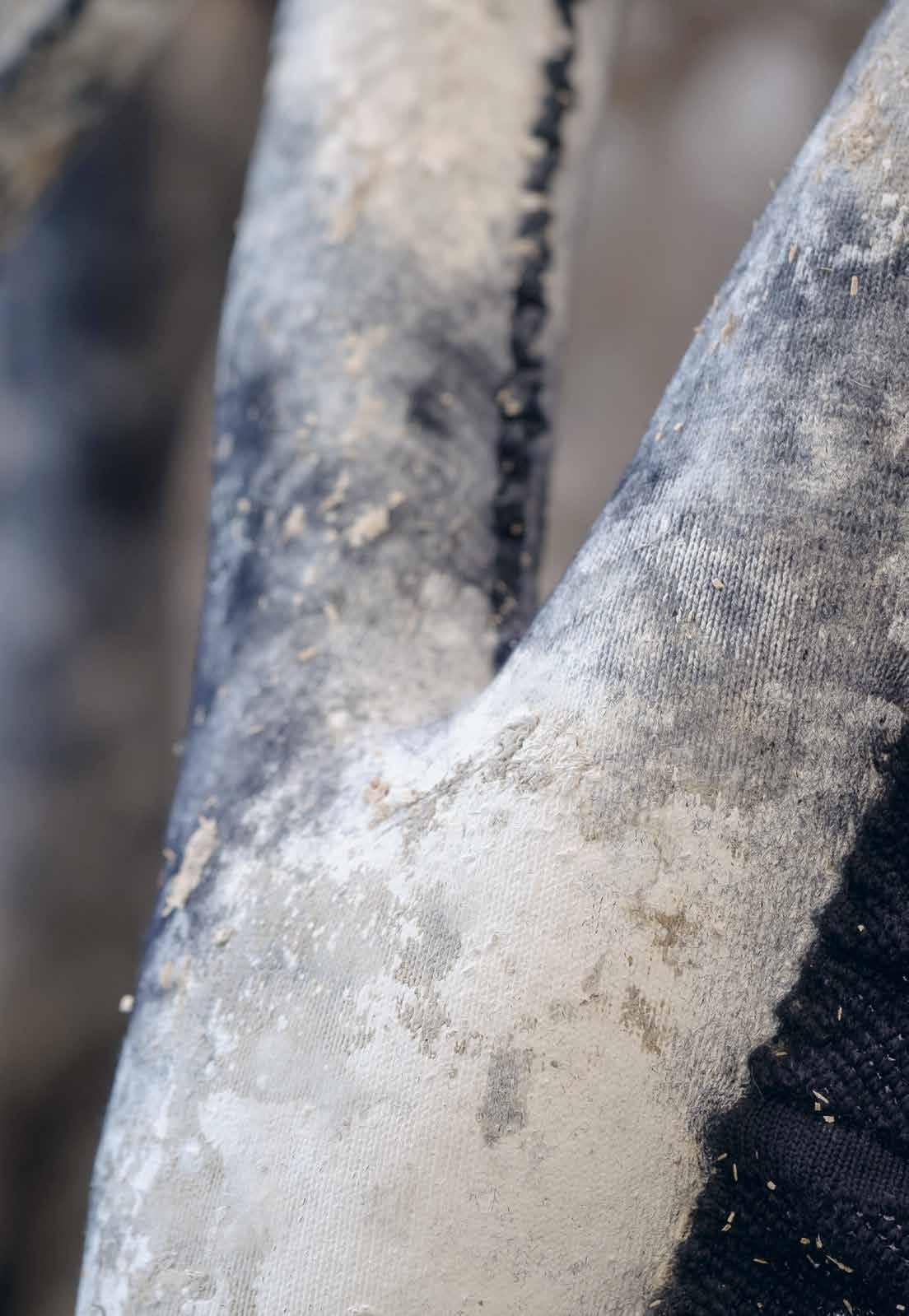
Hi-tech / Low-tech / Bio-tech Crafting the BioKnit Prototype
Data
Application: Freestanding structure
Materials: Wool, mycelium, bacterial cellulose, sawdust, water
Dimensions of prototype:
Height 1.8 m, base diameter 2 m
Weight: Wet 200 kg, dry 50 kg (approx.)
Team
Jane Scott: Responsive and Biohybrid Textiles, Knitting ⚫ Elise
Elsacker: Mycelium Composites, Living Mycelium Materials ⚫ Romy
Kaiser: Textiles, Biofabrication and Mycelium Composites ⚫ Armand
Agraviador: Environmental
Architect, Computational Design ⚫
Aileen Hoenerloh: Bacterial
Cellulose ⚫ Ben Bridgens: Structural and Architectural Design ⚫ Ahmet
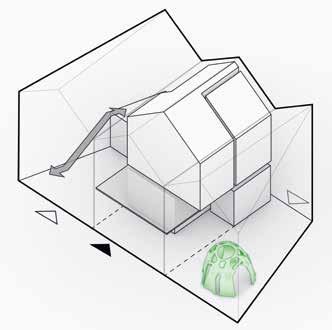
Topcu: Functionally Graded
Mycelium ⚫ Dilan Ozkan: Mycelium
Growth and Digital Fabrication ⚫
Emily Birch: Biological Hygromorphs
⚫ Oliver Perry: Technical Officer
↗ Glossary biohybrid
What could a biological architecture look like? What would it feel like to inhabit a building that has been grown rather than constructed? BioKnit explores how knitted fabric can be used in a biohybrid ↗ system with fungi and bacteria to produce a large-scale, freestanding structure. In contrast to the smooth, hard, rectilinear building interiors which have become ubiquitous over the last hundred years, BioKnit examines how novel construction materials enable us to rethink the spaces and surfaces we inhabit, in this case incorporating organic forms and tactile surfaces. The prototype is composed of mycelium (the root network of fungi), cellulose (produced by bacteria), and knitting (produced using 3D knit technologies). These materials have a considerably lower environmental impact compared to conventional construction materials and provide the opportunity to radically rethink how and what we build.
Figure 2 Location of BioKnit prototype in the OME Figure 1 Detail of BioKnit illustrating mycelium (white) growing through knitted fabric (navy)BioKnit employs advanced knitting technologies to fabricate a shaped tubular textile that acts as a scaffold and scaling agent to guide the growth of mycelium ↗. Together, the knit, mycelium and bulk substrate ↗ materials form a bespoke composite. This structure provides the framework to host two-metre-long bacterial cellulose ↗ panels pre-grown to custom shapes providing a tactile, translucent skin that contrasts with the knitted panels. The making process uses hand assembly techniques throughout, relying on the skill and dexterity of the team to carefully bring together each element of the biohybrid system. Whilst hi-tech computation and digital fabrication tools allow for the concept of a bio-tech architecture to be realised, BioKnit underlines the importance of a tacit understanding of the materiality of each component. It brings together the hi-tech, the low-tech and the bio-tech, applying a deep knowledge of the craft of working with living materials and knitted fabrics to successfully use growth to shape future architectural construction.
BioKnit emerged from questions about how the properties of knit could be harnessed to create flexible, adaptable, low-environmental impact, tactile buildings. We were interested in exploring how the relationship between fibres, yarns and fabrics, fundamental to knitted fabrics, could be engineered to enhance the growth of biomaterials ↗, and how these techniques could be used to begin to think through not only how bio-tech could replace the materials with which we build, but fundamentally change how and what we ‘build’.
A textile acting as a scaffold for mycelium and bacterial cellulose offers not only a technical solution for biofabrication ↗ at a large scale, but also offers an alternative vision for the built environment. This biohybrid textile architecture has the potential to replace hard, rectilinear buildings with soft curvaceous structures and interiors, and indeed could blur the distinction between structure and interior surface. In using biological growth for construction, knit could in some places be subsumed by the living organism, losing stitch definition and changing the properties to form a rigid composite. In other places, it could retain the fabric’s qualities of stretch and drape. The aim from the start was to integrate multifunctionality – diverse properties and characteristics – into a single material; qualities made possible by the combination of industrial knitting technologies, digital programming and biotechnology.
Knitting and architecture might at first seem to be an unlikely pairing: knitting is soft, flexible and extensible, in opposition to the rigid durability of architectural construction. But there is a growing interest in exploring space from the perspective of a material that stretches, expands and readily deforms to enclose objects and space. Researchers including Jenny Sabin, Mette Ramsgaard Thomsen and Sean Ahlquist have pioneered techniques to produce large-scale knitted architectures using the extensibility and tensile strength of knitted fabrics to explore space in new engaging and interactive forms. Lumen (Sabin Studio, 2017) demonstrates the scale achievable using knitting technologies for the MOMA PS1 series in New York. At an architectural scale, knit is also used as permanent formwork for installations such as KnitCandela (Popescu, 2018). Sean Ahlquist’s Social Sensory Architectures utilise knitted fabric’s ability to stretch and contract to produce touch-responsive surfaces as inclusive architectural environments (Ahlquist, 2016). These are tactile architectures that invite inhabitants to touch and interact with the structures.
The ability to produce architectural-scale knitted structures has been facilitated by advances in computation and digital fabrication, providing the tools to model the fabric’s behaviour and resultant geometry prior to knitting. The latest generation of industrial knitting technologies can produce highly complex fabric structures and forms, thanks to advanced programming and sophisticated machine controls. | Figure 3 ↗ | Programmable Knitting, developed in previous work by Jane Scott, uses industrial knitting technologies to engineer environmentally responsive shapechange behaviour into knitted fabrics (Scott, 2018). In this work the configuration of knitted stitches controls the types of shape-change produced, exploiting the potential to specify individual stitches and use different yarns on a stitch-by-stitch basis throughout a fabric.
Biohybrid Construction
Alongside conventional knitted fabric production, composite textiles offer a way to bring together multiple, often opposing, properties to produce technical fabrics suitable for a variety of industrial applications. Textiles are strong and lightweight and so they are often incorporated within composites to reduce the weight of a material whilst achieving high levels of strength. Textile composites are integrated into cars and aeroplanes, as well as the fabric of buildings, because of their high strength-to-weight ratio. A textile composite usually consists of woven fibres (such as glass, carbon or aramid) encased within a polymer ↗ resin (such as epoxy or polyester). These materials offer exceptional mechanical properties, but with negative environmental impacts including high embodied energy and limited end-of-life options. The opportunity to use biological materials in composites could offer a sustainable alternative.

Biohybrid construction systems offer the potential to dramatically reduce the impact of the materials and processes used to construct our built environment. Working with natural fibres and microorganisms, including bacteria and fungal mycelium, could provide a more sustainable building sector by moving away from carbon-intensive materials such as steel and cement. Biomaterials also have the potential to be recycled at end of life (composted and/or shredded and used as a substrate for growing new materials), and have benefits for occupant comfort as they absorb moisture in the air and regulate internal humidity.
Mycelium, the root network of fungi, has enormous potential in architecture as a binder to create bulk composite materials from a wide range of bio-based substrates including woodchip, waste coffee grounds and agricultural waste. The resulting materials have good compressive strength so can be used as lightweight bricks, or as panels that provide a range of functions including thermal and acoustic insulation (Elsacker, 2021). In a natural environment, mycelial networks are expansive, branching out through soils to decompose organic and even inorganic materials (Stamets, 2005). To produce a mycelium composite, the conditions required by the organism are replicated within a controlled environment. Moisture, nutrients, temperature, and light levels must be carefully managed to achieve optimum growth. As mycelium consumes nutrients, it binds to the substrate materials and, when growth is stopped through heat treatment or dehydration, the end result is a coherent composite.
Mycelium has good biocompatibility ↗ with textiles. The natural plant or animal fibres used to create a knitted fabric are composed of materials that mycelium consumes in a natural environment. Therefore depending on the constituent fibres, fabrics can provide both a scaffold to contain and direct growth, and a substrate for mycelium to consume. Tubular knitted fabrics can be filled with a mix of mycelium and substrate materials. This enables the knitting to shape the composite, as well as introducing tensile strength to improve the performance of the resulting biohybrid composite. | Figure 4 ↗ |
Figure 3 An industrial knitting machine showing the needle beds and yarn feeders. This technology has the flexibility to integrate multiple yarns and stitch types into shaped and 3D fabricsCrafting BioKnit with High-tech and Bio-tech Processes
In addition to mycelium, bacterial cellulose was applied to the surface of the knitted structure as a skin. Bacterial cellulose is a flexible sheet material grown through a process of fermentation ↗, with completely different properties to mycelium | Figure 5 ↗ |. Bacterial cellulose can be grown either as a pure culture or through a Symbiotic Culture Of Bacteria and Yeast (known as a SCOBY). When dried, this biomaterial transforms into a leather-like translucent skin. It has textile qualities that have predominantly been exploited in clothing and product design. For BioKnit, the team wanted to explore how mycelium and bacterial cellulose could be applied to the same knit biohybrid, and how working with different microorganisms would change the materiality of the structure.
1 Design Concept Development
The original design concept for the BioKnit prototype was developed based on several aims:
▶ Demonstrate how a biohybrid textile could produce a large-scale, self-supporting structure; large enough for a person to sit inside, and incorporating some kind of skin to provide enclosure.
▶ Minimise material use by understanding the mechanical and aesthetic properties of each material.
▶ Consider how the materials function as composites to produce an efficient structure.

▶ Use textile formwork to hold the substrate securely and uniformly.
▶ Simplify the production process at all stages to reduce fabrication time. | Figure 6 ↗ |
Inspiration for the form began with consideration of how nature builds with fibrous structures. The team looked to trees, climbing plants, fungi, nests and cocoons to create a directory of bioinspired morphologies ↗. Preliminary form studies were generated with computational design software using a randomised tubular geometry | Figures 6, 7 ↗ |. Parametric ↗ inputs allowed variation in the concentration and diameter of the tubes and this led to a variety of initial design ideas.
The use of computational design tools were particularly valuable for exploring material properties both during and after growth. The design process needed to consider the materials in different states to account for the requirements of biofabrication. Materials were both wet and dry, and soft and stiff, at different stages of the process. The initial concern was that the knitted structure would stretch to a high degree when it was filled with a heavy, wet mycelium substrate mix. Both the scale of the structure and the lack of rigidity of the knit and mycelium during the growing period were key concerns. Computational modelling enabled the team to predict how the structure would behave using physics simulation, illustrating the impact of gravity on textile tubes containing different substrate weights.

 Figure 4
Figure 5
Figure 4
Mycelium/knit composite illustrating the mycelium (white) growing through the substrate (wood fibres) and tubular knitted fabric (black)
Figure 5
Figure 4
Figure 5
Figure 4
Mycelium/knit composite illustrating the mycelium (white) growing through the substrate (wood fibres) and tubular knitted fabric (black)
Figure 5
Oikrobia@OME: Closing the Loop
that the industrial production and transportation of food is one of the primary drivers of climate change and biodiversity loss. Oikrobia is predicated on the principle that in order for the built environment to become more sustainable, so too must the food production, distribution, consumption and waste systems that underpin its design. The entanglements between food and buildings make food production and consumption an ideal context in which to test the Tiny Energy concept.
In ‘Oikrobia: a Microbially Driven Architectural Investigation into a Reformed Food System’, food is explored through a microbial lens. The relationship between food and space was interrogated using microorganisms as contributors to architectural futures | Figure 9 ↗ |. In a move away from conventional cooking methods, the research explored microbial fermentation processes that change the texture, flavour, and longevity of foods. These processes led to the development of low-energy cooking techniques that incorporate spatial and environmental parameters for microorganisms, thus informing the human-scale architectural intervention in which Tiny Energy could be implemented (McLeod-Brown, 2020b). Oikrobia has since been used as the foundation of the conceptual Culina GastroLab (Dy, Riley and McLeod-Brown, 2020) for the BioDesign Challenge 2020 and Oikrobia@OME.
Oikrobia@OME tests the principles of Oikrobia at a domestic scale in the HBBE’s experimental house, the OME, by mapping flows of materials and energy, identifying gaps in their circularity, and proposing sustainable ways of closing these gaps to create a holistic system | Figure 10 ↗ |. The OME has a separating toilet installed in the first-floor apartment, with two waste pipes carrying urine and faeces into a small laboratory, in which there is a one-cubic-metre anaerobic digester and bench space for microbial fuel cells. There are exposed services which allow, in due course, gas from the AD to be piped into the kitchen for cooking, and low voltage wiring to be installed, to make efficient use of the electrical supply from the MFCs. There is also external space for raised beds to grow food.
Anaerobic digestion and MFC technologies produce digestate as a ‘waste’ product and generate relatively small amounts of energy compared to the profligate use of energy to which people are accustomed. Oikrobia proposes the introduction of domestic food production and low-energy cooking to make efficient use of these resources and create circularity. An urban garden can use the digestate as an organic fertiliser due to its nutrient-rich composition. Growth of food in an urban environment not only provides sustenance, but dramatically reduces the negative environmental impacts from industrialised agriculture, transportation and packaging. To make the best use of Tiny Energy from biological processes, traditional low-energy food preparation techniques are suggested – including slow-cooking at low temperatures, smoking, pickling and fermentation (a biological process which requires no external energy input). Waste organic matter from food production and preparation, combined with human waste, is returned to the AD and MFC, and the cycle continues.
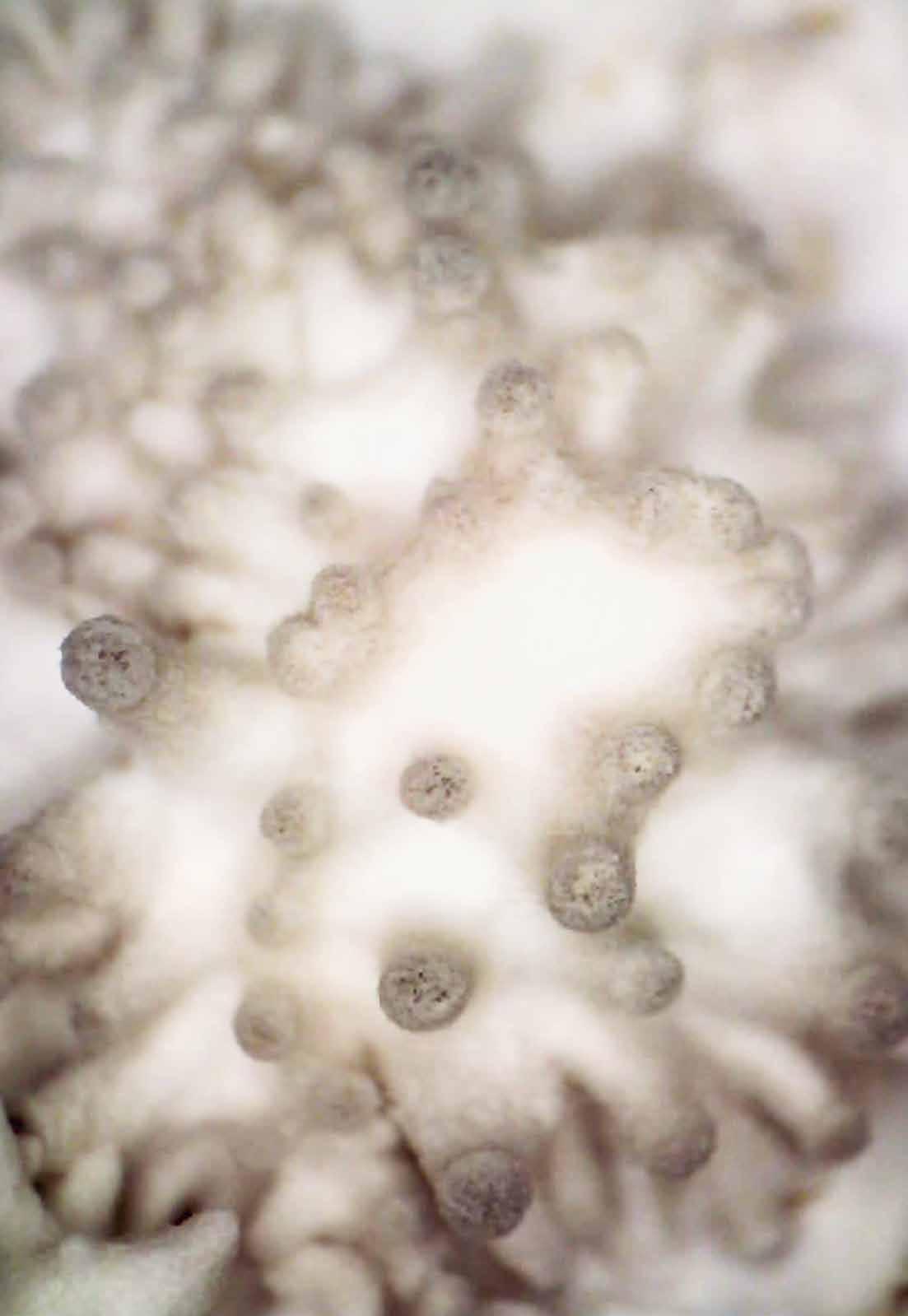
Designing Mushrooms Designing a Living Material Through Bio-digital Fabrication
Context
There is growing interest in designing with nature where living organisms such as algae, bacteria, and fungi are starting to be used as architectural materials. Unlike traditional building materials, living cells exhibit their own agency: an ability to sense, compute and respond to environmental stimuli. However, their complex biosystems and behaviours are not always predictable and controllable, making them difficult to work with. If we are to work successfully with these materials, we need to explore new methods and processes of fabrication that work alongside their biological processes. Working with digital systems and parameters provides a level of predictability and an understanding of a means of
navigating biological complexity.
The research described here focuses on the digital fabrication of living materials. Mycelium (the root system of fungi) can be used to grow bulk materials; however, current approaches tend to be cultivated in moulds. This study suggests a fabrication process that uses fungi as a biomaterial probe ↗, in which the fruiting body is grown with minimal

Parametric Design –Issues and Lessons
physical intervention but where the growth of the fruiting body is guided through the robotic control of the environment temperature, humidity, CO2 level, and light exposure | Figure 2 ↗ |. The fabrication process uses the natural self-assembly capability of the fungus whilst guiding mushroom growth with parameters as a form of bio-digital fabrication. This method enables the fungus to reveal its inherent potential, which comes from having a metabolism and an ability to grow and adapt autonomously. Rather than building a catalogue of mushrooms by 3D scanning them | Figure 3 ↗ |, experiments were designed to understand the influence of environmental conditions as parameters, allowing the designer to test the concept of biological parametrics. This questions how far the designer can push the morphology of an organism by setting a range of particular environmental factors. Further, it questions whether parametrics can be used as a method in a predictive way and as a template for other bio-designers working with different organisms. This approach is defined as the Probability Space Method (PSM).
While testing this parametric ↗ design approach on fungi, the main issue was the highly complex and non-linear behaviour of living materials. The same effect did not always cause the same morphological results on mushrooms growing under the same environmental conditions. Moreover, in some of the samples, small changes in environmental conditions created tipping points and led to developmental outcomes that were not easy to attribute to single or limited sets of parameters. In essence, it is the non-linear behavioural pattern of the living materials that leads to an abundance of variations in the final product (Ozkan et al., 2022). However, the developmental plasticity of mushrooms allowed me to demonstrate distinct trends and a linear parametric behaviour within the organism. | Figures 4 and 5 ↗ | demonstrate different mushroom morphologies achieved by altering environmental conditions. There was a correlation between environmental parameters and morphological outcomes. What is true for mushrooms may also be true for other sorts of biological systems, and thus a parametric approach to biodigital fabrication can be a new way of crafting living materials.
Conclusions and Future Potential
The correlation between growth parameters and material response means it is possible to predict the behaviours of biological material in between tipping points. This enables me to work with organisms as they grow in order to achieve the desired form and properties that exist within their plasticity. Therefore, a prediction method or model is needed for non-linear materials that can suggest linearities under given conditions.
Due to the nature of living materials, designers’ intent and outcomes do not always proceed in parallel. The Probability Space Method (PSM) is therefore proposed as a way to indicate zones where the growth possibility of the organism is low or high. It is an architectural representation of a spatial range in which the newly grown mushroom can take form. PSM creates a language that everyone can understand, aims to help in reducing uncertainty, and shows how far a designer can step back. It also differs from tolerance. Both in engineering and biology, tolerance is used to determine the amount of space required for error or survival. High to low extreme values determine the range. Probability Space does not represent the range of tolerance; rather, it represents the possible states of the organism for a specific environmental condition | Figure 6 ↗ |.
References
Ozkan, D., Dade-Robertson, M., Morrow, R., Zhang, M., (2022) ‘Are mushrooms parametric?’ Biomimetics, 7(2), 60. Special Issue: Fungal Architectures.



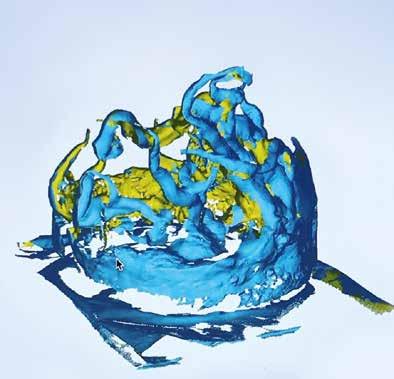
 Figure 3
Figure 3

 Figure 4
Oyster mushroom grown in a higher and lower concentration of carbon dioxide
Figure 5
Oyster mushroom grown in high and low humidity
Figure 6
The probability space of newly grown mushrooms
Figure 4
Oyster mushroom grown in a higher and lower concentration of carbon dioxide
Figure 5
Oyster mushroom grown in high and low humidity
Figure 6
The probability space of newly grown mushrooms



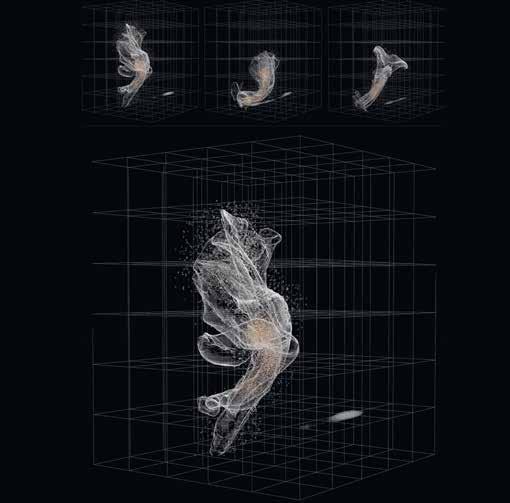 Figure 5
Figure 5

3.5 Tiny Urban BioReactor Transforming Domestic Waste
Deployment of futuristic biotechnologies within home-like settings would permit decentralised bioprocessing to handle domestic waste. Biotechnology can remodel these materials to become useful molecules for the home; for example drugs, flavourings or fuels. Individual homes could have tiny, urban bioreactors ↗, where residents can decide how to upgrade their waste materials in ways that best serve them.
A Tiny Urban BioReactor (TUBR) represents an accessible and useful deployment of this approach to biotechnology. It gives people agency over how their waste is handled, and empowers individuals and communities to make useful products. Imagine if the bin at your back gate was producing valuable materials for your home. Paper bins may be replaced with a microbial culture fed by yesterday’s newspaper that can generate medicines. Or maybe you’d prefer to utilise a genetically modified strain that can turn lignin ↗ into capsaicin (the active component of chilli peppers) to spice up your meals?
↗ Glossary bioreactors lignin Figure 1 Use of microbial cultures to convert domestic waste into useful products; in this case making beer from waste paper.Editors
Ruth Morrow, Ben Bridgens, Louise Mackenzie
Acquisitions editor
Baharak Tajbakhsh
Project management
Angelika Gaal, Freya Mohr
Production
Angelika Gaal
Copy editing
Patricia Kot, Alun Brown
Image editing
Pixelstorm Litho & Digital Imaging
Layout, cover design and typesetting
HE&AD Büro für Gestaltung
Printing
Grafisches Centrum Cuno GmbH & Co. KG
Library of Congress Control Number: 2023933331
Bibliographic information published by the German National Library
The German National Library lists this publication in the Deutsche Nationalbibliografie; detailed bibliographic data are available on the Internet at http://dnb.dnb.de.
This work is subject to copyright. All rights are reserved, whether the whole or part of the material is concerned, specifically the rights of translation, reprinting, re-use of illustrations, recitation, broadcasting, reproduction on microfilms or in other ways, and storage in databases.
For any kind of use, permission of the copyright owner must be obtained.
ISBN 978-3-0356-2579-0
e-ISBN (PDF) 978-3-0356-2580-6
© 2023 Birkhäuser Verlag GmbH, Basel P.O. Box 44, 4009 Basel, Switzerland
Part of Walter de Gruyter GmbH, Berlin/Boston
9 8 7 6 5 4 3 2 1 www.birkhauser.com
Image Credits
Page/Figure
Armand Agraviador 25/4, 59/1, 61 /2, 64 /6, 66/ 7, 67/8, 77/2, 85/8, 91 /2, 96/9, 103/2, 107/6 + 7, 117/1, 131 /1
Mahab Aljannat 86/13 - 15
Thora Arnardottir 149/1, 150/1, 152 /2, 153/3 + 4, 155/5
Emily Birch 156/1, 157/2, 159/3 + 4, 160/5, 161 /6
Karolina Bloch
